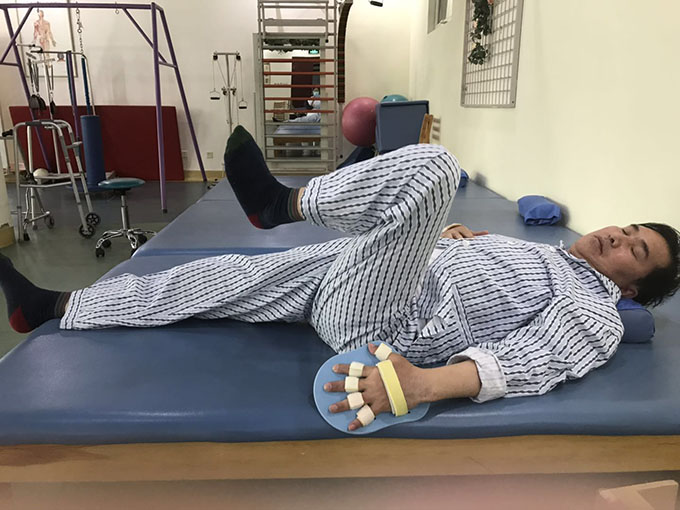Jin Yang Gyo-Cerebral Hemorrhage Sequela-(Korea)
 Name: Jin Yang Gyo
Name: Jin Yang Gyo
Sex: Male
Nationality: Korean
Age: 52Y
Diagnosis: 1. Cerebral Hemorrhage Sequela 2. High Blood Pressure (L3)
Discharge Date: 2019/05/27
Before treatment:
Four years ago the patient suddenly experienced left limb movement disturbance during working. He went to the local hospital and found that his blood pressure was elevated and the systolic blood pressure was about 210 mmhg. The skull CT found cerebral hemorrhage in the right basal ganglia region and was diagnosed as "cerebral hemorrhage". A drainage tube was placed after decompression and discharged about 15 days later. After discharge, rehabilitation training was performed (twice a week) and the function of limb activity was slightly improved. At present the patient has difficulty in lifting the left arm, difficulty in finger movement, difficulty in lifting the left foot, walks with the aid of crutches and has sensory dysfunction in the left half of his body.
Admission PE:
Bp: 116/86mmHg, Hr: 68/min, breathing rate: 18/m, body temperature: 36.6 degrees, height, 182cm, weight, 86.5kg. The patient had passable nutrition status, normal physical development, no damage or bleeding spots of the skin or mucosa, no congestion in the oropharynx and no cyanosis around the lips. He had a symmetrical chest, clear respiratory sounds of both lungs, no dry or moist rales heard and no bulge in the precordia. There were strong heart sounds with regular rhythm and no obvious murmur heard in the valves. He had a flat and soft abdomen with no tenderness and masses, normal liver and spleen, negative shifting dullness, normal spinal column and no edema of the legs.
Nervous System Examination:
The patient was alert, had good spirit, clear speech, normal memory, orientation and calculation abilities. He had round and equal pupils, with a diameter of 3 mm, reacting sensitively to light, free eyeball movement and no double vision. There was symmetrical forehead wrinkle, shallow nasolabial fold on the left, relatively weak cheek-bulging on the left, normal lifting of the soft palate bilaterally, slightly left deviation of the uvula, middle tongue when extended out and right deviation of the mouth corners when showing his teeth. He had normal swallowing, a soft neck, strong neck-turning, weak shrug on the left and a normal shrug on the right. Muscle power: right arm and leg 5; abductor of left arm 3+; flexor and extensor 5-; left leg 3+ and a gripping power of 3. There was high muscle tone of the left interphalangeal joint, weak dorsal feet flexion, reduced plantar feet flexion, high muscle tone of the left arm when adducting, relatively low muscle tone of the left leg and normal muscle tone of the right side. He had active biceps reflex, periosteal reflex and knee reflex on the left and right sides, negative ankle clonus and palm-jaw reflex bilaterally. There was a negative Rossilimo sign and Hoffmann sign bilaterally, positive Babinski sign on the left, questionable positive Babinski sign on the right. Pain sense was reduced 50% on the left with normal pain sense on the right. Almost normal fast alternate, finger to finger and finger to nose movement on the right, unfeasible fast alternate, finger to finger and finger to nose movement on the left. Positive Romberg sign, negative meningeal irritation sign.
Treatment:
After the admission he received 3 nerve regeneration treatments (neural stem cells and mesenchymal stem cells) to repair his damaged nerves, replace dead nerves, nourish nerves, improve body environment, regulate his immune system and improve blood circulation. This was combined with rehabilitation training.
Post-treatment:
After 14 days treatment his proximal muscle strength of the left arm improved. He could now lift the left arm up to his forehead, his left grip strength was better than before and the muscle strength was at level 4 (20%). His left leg muscle strength was better than before, his knee and hip flexion was more standard and stable than before and his left foot’s dorsal flexion got better. His balance was better than before, he was able to stand with his eyes closed and his stability was better than before.


